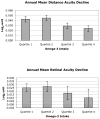ω-3 intake and visual acuity in patients with retinitis pigmentosa receiving vitamin A
- PMID: 22332205
- PMCID: PMC3552384
- DOI: 10.1001/archophthalmol.2011.2580
ω-3 intake and visual acuity in patients with retinitis pigmentosa receiving vitamin A
Abstract
Objective: To evaluate whether a diet high in long chain ω-3 fatty acids can slow the rate of visual acuity loss among patients with retinitis pigmentosa receiving vitamin A palmitate.
Methods: We calculated dietary intake from questionnaires completed annually by 357 adult patients from 3 randomized trials who were all receiving vitamin A, 15 000 IU/d, for 4 to 6 years. Rates of visual acuity decline were compared between those with high (≥0.20 g/d) vs low (<0.20 g/d) ω-3 intake. Analyses took age into account.
Results: Mean rates of decline of acuity were slower among those with high ω-3 intake: Early Treatment Diabetic Retinopathy Study distance acuity: high intake=0.59 letter per year, low intake=1.00 letter per year,P=.001; Snellen retinal acuity: high intake=1.5% per year, low intake=2.8% per year, P=.03.
Conclusions: We conclude that mean annual rates of decline in distance and retinal visual acuities in adults with retinitis pigmentosa receiving vitamin A, 15 000 IU/d,are slower over 4 to 6 years among those consuming a diet rich in ω-3 fatty acids. To our knowledge, this is the first report that nutritional intake can modify the rate of decline of visual acuity in retinitis pigmentosa.
Figures


Comment in
-
ω-3 Intake in patients with retinitis pigmentosa receiving vitamin A.JAMA Ophthalmol. 2013 Feb;131(2):267-8. doi: 10.1001/jamaophthalmol.2013.590. JAMA Ophthalmol. 2013. PMID: 23411905 No abstract available.
-
ω-3 Intake in patients with retinitis pigmentosa receiving vitamin A-Reply.JAMA Ophthalmol. 2013 Feb;131(2):267-8. doi: 10.1001/jamaophthalmol.2013.1722. JAMA Ophthalmol. 2013. PMID: 23411906 No abstract available.
References
-
- Leber T. Die Pigmentdegeneration der Netzhaut und mit ihr verwandte Erkränkungen. In: Graefe A, Saemisch-Hess, editors. Handbuch der gesammten Augenheilkunde. 2. Vol. 7. Leipzig: TW Engelmann; 1916. pp. 1076–1225.
-
- Bell J. Retinitis pigmentosa and allied diseases of the eye. In: Pearson K, editor. Treasury of Human Inheritance. Vol. 2. London: Cambridge University Press; 1922. pp. 1–28.
-
- Ammann F, Klein D, Franceschetti A. Genetic and epidemiological investigation of pigmentary degeneration of the retina and allied disorders in Switzerland. J Neurol Sci. 1965;2:183–196. - PubMed
Publication types
MeSH terms
Substances
Grants and funding
LinkOut - more resources
Full Text Sources
Other Literature Sources
Medical

